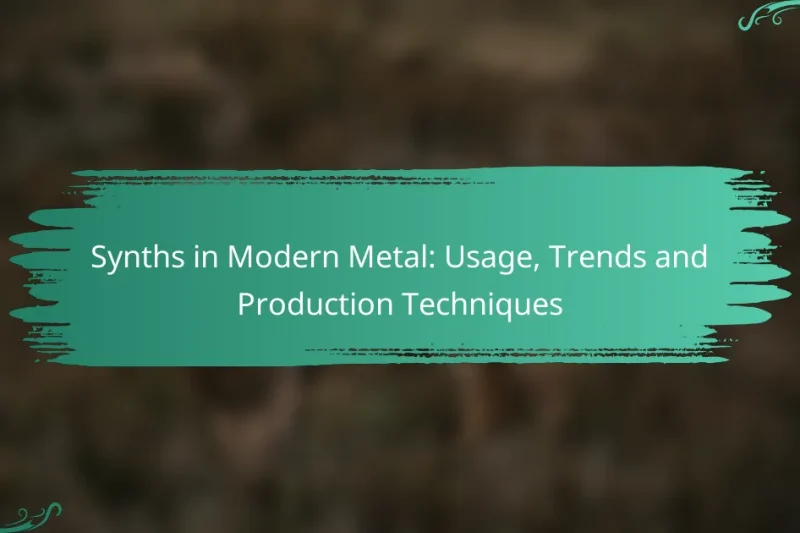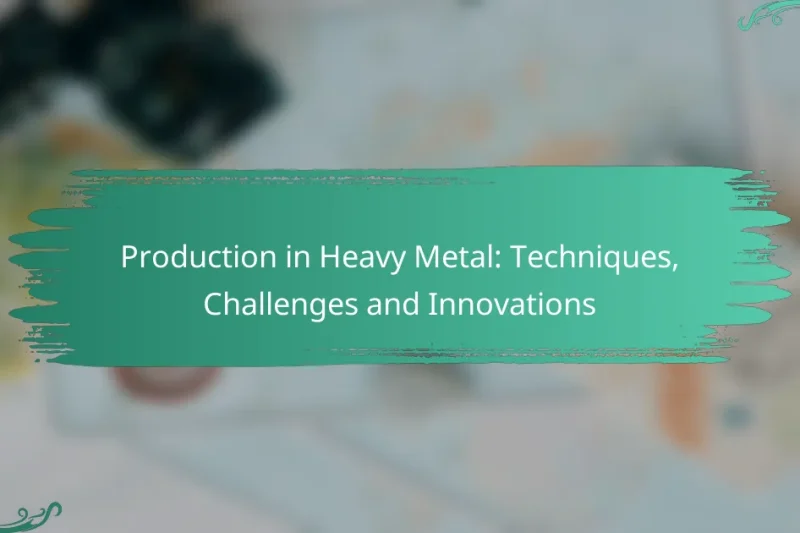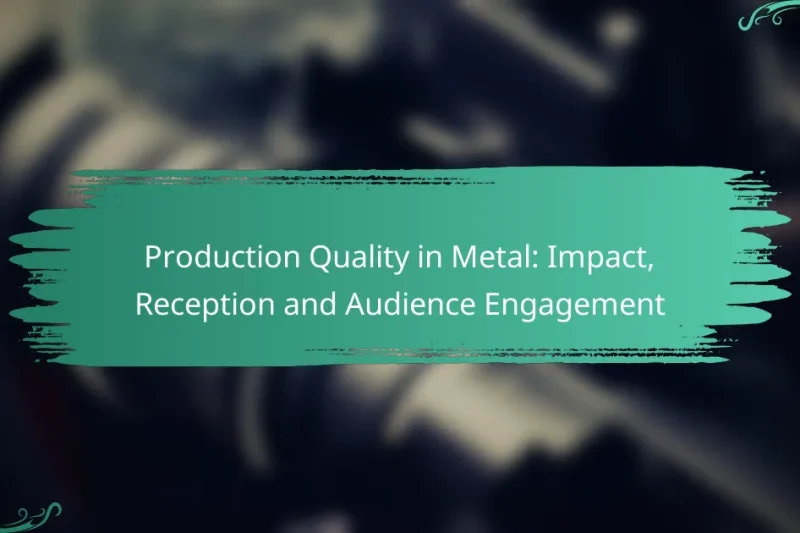Mixing and mastering are vital processes in metal music, shaping the overall sound quality and enhancing … Mixing and Mastering in Metal: Importance, Techniques and ToolsRead more
Metal Production Techniques
Metal production techniques encompass a variety of processes that convert raw materials into usable metals, tailored to the specific type of metal being produced. Key methods include steelmaking, which utilizes the Bessemer process and electric arc furnaces, and aluminum smelting, particularly in regions like Canada where renewable energy sources enhance efficiency and sustainability.
Synths in Modern Metal: Usage, Trends and Production Techniques
Synths are increasingly integrated into modern metal music to enhance soundscapes, add depth, and create unique … Synths in Modern Metal: Usage, Trends and Production TechniquesRead more
Production in Heavy Metal: Techniques, Challenges and Innovations
Production in heavy metal music involves a range of techniques, including tracking, mixing, and mastering, all … Production in Heavy Metal: Techniques, Challenges and InnovationsRead more
Digital Audio Workstations for Metal: Features, Benefits and Tips
Digital Audio Workstations (DAWs) play a crucial role in producing metal music, offering features tailored to … Digital Audio Workstations for Metal: Features, Benefits and TipsRead more
Guitar Tone in Metal: Equipment, Settings and Techniques
Achieving the perfect guitar tone for metal requires a combination of high-gain amplifiers, solid-body electric guitars, … Guitar Tone in Metal: Equipment, Settings and TechniquesRead more
Production Quality in Metal: Impact, Reception and Audience Engagement
Production quality plays a crucial role in the reception of metal music, affecting both audience perception … Production Quality in Metal: Impact, Reception and Audience EngagementRead more
DIY Recording vs Professional Studios: Which Is Better and When to Use
Choosing between DIY recording and professional studios involves weighing factors like budget, project complexity, and desired … DIY Recording vs Professional Studios: Which Is Better and When to UseRead more
What are the primary metal production techniques?
The primary metal production techniques include processes that transform raw materials into usable metals. These techniques vary based on the type of metal being produced and involve distinct methods and technologies.
Steelmaking
Steelmaking is the process of producing steel from iron ore and other materials. It typically involves two main methods: the Basic Oxygen Process (BOP) and the Electric Arc Furnace (EAF). BOP is more common for large-scale production, while EAF is often used for recycling scrap steel.
Key considerations in steelmaking include the quality of raw materials and the desired properties of the final product. For instance, the carbon content can significantly affect the strength and ductility of the steel.
Aluminum smelting
Aluminum smelting is the process of extracting aluminum from its oxide, primarily bauxite, through electrolysis. The Hall-Héroult process is the most widely used method, where aluminum oxide is dissolved in molten cryolite and subjected to an electric current.
This technique requires significant energy, making it essential to consider the cost of electricity and the environmental impact. Efficient smelting operations often implement measures to reduce greenhouse gas emissions and energy consumption.
Copper refining
Copper refining involves purifying copper from its ores or scrap materials. The primary methods include pyrometallurgy and hydrometallurgy. Pyrometallurgy involves smelting copper concentrates at high temperatures, while hydrometallurgy uses aqueous solutions to extract copper.
Refining copper can yield high-purity metal, often exceeding 99.9%. Factors such as ore grade and market demand influence the choice of refining method and the overall economic viability of the process.
Iron casting
Iron casting is a manufacturing process where molten iron is poured into molds to create various shapes and components. Common methods include sand casting, investment casting, and die casting. Each method has its advantages in terms of precision, cost, and production volume.
Key considerations in iron casting include the type of iron used, mold material, and cooling rates, which can affect the final product’s mechanical properties. Proper mold design is crucial to minimize defects and ensure dimensional accuracy.
Metal extrusion
Metal extrusion is a process that involves forcing heated metal through a die to create long shapes with a uniform cross-section. This technique is commonly used for materials like aluminum and copper, allowing for the production of complex profiles.
Factors to consider in metal extrusion include the temperature of the metal, die design, and extrusion speed. Proper control of these variables can enhance product quality and reduce waste, making it a cost-effective method for producing metal components.
How does steelmaking work in the United States?
Steelmaking in the United States primarily involves two methods: the Bessemer process and electric arc furnaces. These techniques transform raw materials like iron ore and scrap metal into steel through distinct processes that emphasize efficiency and quality.
Bessemer process
The Bessemer process is one of the earliest methods for producing steel from molten pig iron. This technique involves blowing air through the molten iron to remove impurities, resulting in a stronger and more malleable metal.
While this method was revolutionary in the 19th century, it has largely been replaced by modern techniques due to limitations in controlling the composition of the steel. Today, it is rarely used in the U.S. steel industry, which favors more precise methods.
Electric arc furnace
The electric arc furnace (EAF) is a widely used steelmaking method in the United States, particularly for recycling scrap metal. This process involves melting scrap steel using high-voltage electric arcs, allowing for quick production and lower emissions compared to traditional methods.
EAFs are flexible and can produce a variety of steel grades, making them suitable for both large and small-scale operations. This method has gained popularity due to its efficiency and the growing demand for sustainable practices in metal production.
What are the advantages of aluminum smelting in Canada?
Aluminum smelting in Canada offers significant benefits, primarily due to the country’s abundant and renewable hydroelectric power. This energy source not only reduces operational costs but also minimizes the environmental impact associated with aluminum production.
Energy efficiency
Energy efficiency is a critical advantage of aluminum smelting in Canada, where hydroelectric power is widely available. The use of this renewable energy source allows smelters to operate at lower costs compared to regions reliant on fossil fuels, which can lead to substantial savings in electricity expenses.
Additionally, Canadian smelters often implement advanced technologies that enhance energy efficiency, such as improved cell designs and automation systems. These innovations can lead to energy savings of up to 20% compared to older smelting methods.
Lightweight properties
Aluminum’s lightweight properties make it an ideal material for various applications, particularly in the automotive and aerospace industries. The reduced weight of aluminum components can lead to improved fuel efficiency and lower emissions in vehicles, making it a preferred choice for manufacturers aiming to meet stringent environmental regulations.
In Canada, the lightweight nature of aluminum also supports the development of innovative products, such as lightweight structures in construction and packaging. This versatility contributes to the material’s growing demand, further solidifying Canada’s position in the global aluminum market.
What are the environmental impacts of metal production?
Metal production significantly affects the environment through carbon emissions, water usage, and waste generation. Understanding these impacts is crucial for developing more sustainable practices in the industry.
Carbon emissions
Carbon emissions from metal production primarily arise during the extraction and processing of ores. The smelting process, which involves heating ores to extract metals, can release substantial amounts of CO2, contributing to climate change.
For instance, steel production is one of the largest industrial sources of carbon emissions, accounting for approximately 7-9% of global emissions. Transitioning to renewable energy sources and adopting carbon capture technologies can help mitigate these emissions.
Water usage
Water usage in metal production is significant, particularly in processes like cooling, washing, and hydrometallurgy. The industry can consume thousands of liters of water per ton of metal produced, which can strain local water resources.
In regions where water scarcity is a concern, such as parts of Australia and the Middle East, efficient water management practices are essential. Techniques like recycling water within production processes can reduce overall consumption and lessen environmental impact.
Waste generation
Metal production generates various types of waste, including slag, tailings, and hazardous materials. These byproducts can pose risks to the environment if not managed properly, leading to soil and water contamination.
Implementing waste reduction strategies, such as recycling scrap metal and treating hazardous waste, is crucial. Many companies are now adopting circular economy principles to minimize waste and enhance resource efficiency in metal production.
What are the key factors in selecting metal production techniques?
Key factors in selecting metal production techniques include cost efficiency and material availability. These elements significantly influence the overall feasibility and sustainability of the production process.
Cost efficiency
Cost efficiency is crucial when choosing metal production techniques, as it directly impacts the bottom line. Techniques that minimize waste and reduce energy consumption tend to be more economical, making them preferable for large-scale operations.
For example, processes like continuous casting can lower costs by reducing the need for additional processing steps. It’s essential to evaluate both initial investment and long-term operational costs to determine the most cost-effective method.
Material availability
Material availability refers to the accessibility of raw materials needed for metal production. Techniques should be selected based on the local availability of these materials, which can vary widely by region.
For instance, if a specific metal is abundant in a region, using production methods that leverage this material can enhance efficiency and reduce transportation costs. Always consider local suppliers and the potential for sourcing recycled materials to improve sustainability and reduce costs.






